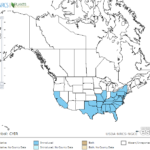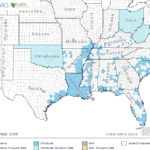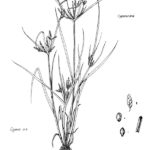Cyperus iria
Non-Native
USDA, NRCS. 2018. The PLANTS Database (http://plants.usda.gov, 28 March 2018). National Plant Data Team, Greensboro, NC 27401-4901 USA.
Illustration courtesy of University of Florida/IFAS Center for Aquatic and Invasive Plants. Used with permission.
What is Ricefield Flat Sedge?
Physical Characteristics
Leaves:
- Crowded near the base
- Shorter than the stem
Flowers:
- 0.13-0.39 inches long
- 0.05-1.5 inches wide
- 2-22 flowers
- Brownish or golden brown in color
Fruit:
- Dry
- Does not open to release seed when ripe
- 3-angled
- About 0.05 inches long
Stem:
- Hollow stems
- 3.16-24 inches long
Where Does it Grow?
Non-Native
Ricefield flat sedge can be found in wet clay in coastal rice-growing areas, in water of freshwater canals, and on the edge of ponds.
Pros and Cons of Ricefield Flat Sedge
Ricefield flat sedge is non-native to the United States, and tends to disrupt the ecosystem by pushing the native species out of their habitat.
This plant is not native to North America, but has naturalized in much of the United States. While it is not illegal to possess this plant in Texas, it should not be introduced into new water bodies and should be treated with herbicide when present.



